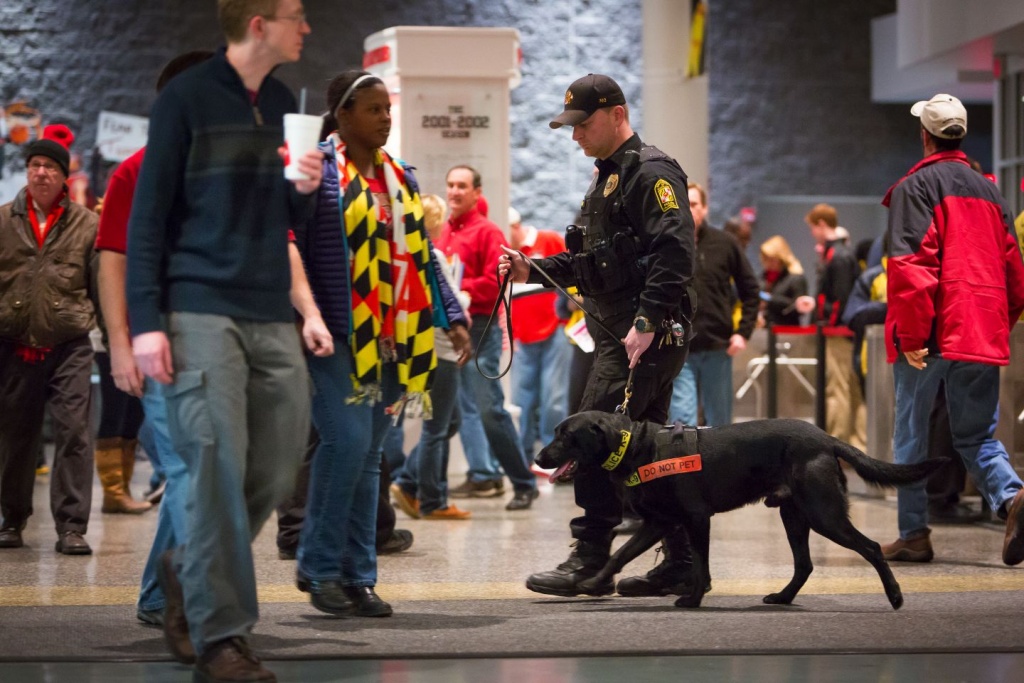 Canines are an effective resource for detection operations. The Science and Technology Directorate's (S&T's) Detection Canine Program provides the Homeland Security Enterprise (HSE)—including DHS Components, state, local, tribal, and territorial agencies (SLTT)—with the tools, techniques, and knowledge to better understand, train, and deploy detection canines in their operational environments.
Canines are an effective resource for detection operations. The Science and Technology Directorate's (S&T's) Detection Canine Program provides the Homeland Security Enterprise (HSE)—including DHS Components, state, local, tribal, and territorial agencies (SLTT)—with the tools, techniques, and knowledge to better understand, train, and deploy detection canines in their operational environments.
S&T is working with DHS partners, including the Transportation Security Administration, other federal agencies, and state and local law enforcement, to:
- Provide a central focal point for DHS canine research, development, test and evaluation;
- Promote intra-department and interagency coordination to drive the development of technologies with broad application; and
- Provide a specific focus on the Person-Borne Improvised Explosive Device (PBIED) detection canine.
Program Capabilities
- State of the Art Lab Analysis
- Independent/Expert Test and Evaluation Assessment
- HSE Community Outreach
- Cross Discipline Odor Discrimination
- Interagency Partnerships
Specific Focus Areas
- Development and testing of canine training aids that can be used to improve and test canine ability to detect new threats;
- Independent operational test and evaluation capability for detection canines; discovering canine strengths and weaknesses by performing in-field assessments; and using a scientifically rigorous approach with statistically significant results to enhance and validate testing methods; and
- Canine R&D structure and function with focus on basic understanding of canine olfaction, cognition, genetics, genomics and breeding, and behavior to improve operational efficiencies and training methods.
Person-Borne Improvised Explosive Device Canine Initiative
The DHS S&T PBIED Canine Initiative was started in 2012 in order to understand the strengths and limits of canines specially trained to detect PBIEDs being carried in by people, either on their person or in bags, in mass transit and large crowd event operational environments. This type of parametric study and testing has not previously been done, but is critical to scientifically determine the limits of performance.
Since 2012, thousands of data points have been collected during hundreds of individual assessment events involving federal, state, and local law enforcement partner agencies—the results of which have informed the creation of Person-borne Explosive Detection (PBED) Canine Training Guidelines. These guidelines include advanced training techniques that have proven successful in fielding proficient PBED canine teams, and are specifically designed for canine officers familiar with traditional Explosive Detection Canine (EDC) training who would like to “up-train” their teams to develop PBED capability.
Regional Explosives Detection Dog Initiative
The Regional Explosives Detection Dog Initiative (REDDI®) was started in 2017 as an outreach effort aimed at advancing the knowledge and capabilities of our nation’s detection canine teams. This initiative addresses the need for a centralized focal point within DHS to address mission requirements, conduct operationally relevant research, facilitate knowledge sharing, and act as a repository of expert advice for the detection canine community. Agencies interested in hosting a REDDI® event can send a request to STK9@hq.dhs.gov.
- News Release: S&T Launches New Training Guideline for Detection Canine Teams
- News Release: DHS S&T Awards Funding to Auburn University for Detection Canine Research and Development
- Snapshot: Helping State and Local Canine Teams be REDDI® for Anything
- Regional Explosive Detection Dog Initiative, Ft Meyers, FL (video)
- Detection Canine Fact Sheet
- Effect of Training Method on Detection Dog Learning Rates and Generalization Podcast Episode (Audio)
- Effect of Odor Training Paradigm on Acquisition and Generalization of Explosives (Video)
- Non-Detonable Training Aids for Explosives Detection Canines
- Best Practices for Detection Canine Training & Testing Report
- Canine Field Decontamination Using Premade Wipes
- Detection Canine Program Person-Borne IED Initiative Fact Sheet and Video
- Effects of Heat and Acclimatization on the Capability of Detection Canines Guide
- Progressive Increases of Blank Searches Improve Detection Canine Performance with Infrequent Target Odors (Infographic)
- Regional Explosives Detection Dog Initiative (REDDI®) Fact Sheet and Video
- Technology and Innovation Exchanges (TIES) Event Video
- Effectiveness of Marker Training for Detection Dogs (Frontiers in Veterinary Science (2025)).
- Effect of Rapid Changes in Environmental Conditions on Canine Detection of Methyl Benzoate (2025)
- The Effect of Training Paradigm on Dogs’ (Canis Familiaris) Acquisition and Generalization of Smokeless Powders (Applied Animal Behaviour Science (2025)).
- Impact of Variations in Training Schedules on Dogs’ Acquisition and Retention of an Odor Detection Task (2024)
- Inattentional Blindness in Dogs (Applied Animal Behaviour Science (2023)).
- Longitudinal Stability of Detection Dog Behavioral Assessment: A Follow-up Study of Long-term Working Cuccess (Applied Animal Behaviour Science (2023)).
- A Laboratory Model of Canine Search Vigilance Decrement, I (Journal of the Experimental Analysis of Behavior (2023)).
- A Laboratory Model of Canine Search Vigilance Decrement, II: Noncontingent Reward and Pavlovian Appetitive Stimuli (Journal of the Experimental Analysis of Behavior (2023)).
- Part, III: Increasing Odor Detection Performance After Training with Progressively Leaner Schedules of Odor Prevalence (Journal of the Experimental Analysis of Behavior (2023)).
- An Automated Canine Line-up for Detection Dog Research (Frontiers in Veterinary Science (2021)).
- Explosive Odor Signature Profiling: A Review of Recent Advances in Technical Analysis and Detection (Forensic Science International (2023)).
- Genome Scanning of Behavioral Selection in a Canine Olfactory Detection Breeding Cohort (Scientific Reports (2022)).
- Headspace Sampling of Smokeless Powder Odor in a Dynamic Airflow Context (Forensic Chemistry International (2022)).
- Review: Headspace Components of Explosives for Canine Non-detonable Training Aid Development (Forensic Chemistry (2023)).
- Routine Decontamination of Surfaces Relevant to Working Dogs: Neutralization of Superficial Coronavirus Contamination - (PubMed - NIH (2023))
- Use of Mass Spectrometric Vapor Analysis to Improve Canine Explosive Detection Efficiency (Analytical Chemistry (2017)).
- Vapor Signatures of Double-Base Smokeless Powder and Double-Gunshot Residues for Supporting Canine Odor Imprinting (ACS Omega Journal (2022)).
Learn more about us and discover how your organization can partner with S&T to make the homeland more secure.
